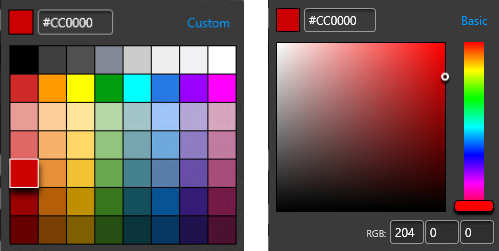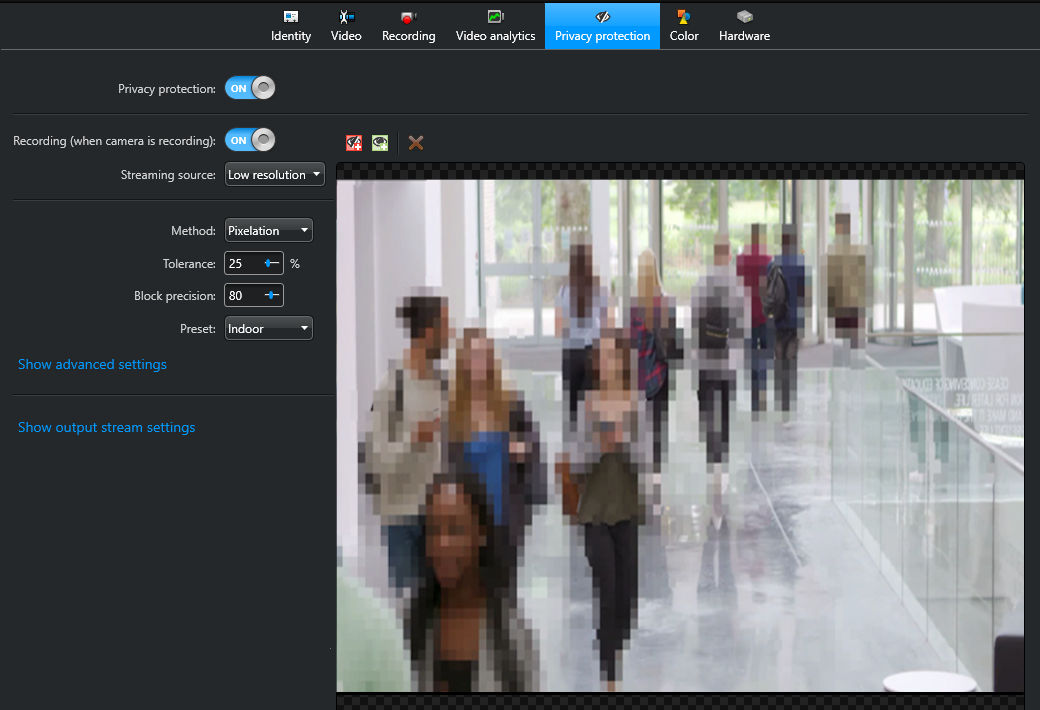To anonymize a video stream, you must configure privacy protection on each
camera.
What you should know
Video is anonymized by masking the areas where individuals or objects are moving.
- The precision of the masking blocks (block size) is the same for the whole field of
view. In distorted scenes, such as with fisheye cameras, this can result in coarse
anonymization towards the edges of the scene.
- Privacy protection only supports PTZ cameras that are used as fixed cameras. If a camera
is moved after privacy protection is enabled, the entire stream is anonymized for the
duration of the Startup learning period (default = 60
seconds).
- Privacy protection is resource-intensive:
- Privacy protection adds one extra stream per camera: the privacy-protected public
stream.
- Anonymization is computed and applied to the decoded image.
To configure privacy protection:
-
From the Area view task, select the camera to configure, and click
the Privacy protection tab.
-
Set the Privacy protection option to
ON.
Any user who does not explicitly request to remove privacy protection gets the
anonymyzed video stream.
-
Set the Recording (when camera is recording) option.
ON:

When recording is triggered on the camera, both the Public (privacy-protected)
stream and the Private (confidential) stream are recorded.
OFF:

The privacy-protected stream is never recorded, only the confidential stream is. This
means that when a user without the Remove privacy protection privilege requests
to play back video from that camera, no video is available.
-
Configure the basic privacy protection settings.
Streaming source:

Standard stream (default = Low
resolution) is used to generate the anonymized stream. Although the Archiver role always
archives the Recording stream as the original (private) stream, you can
select a different stream to archive as the anonymized (public)
stream.
Method:

Appearance of the masking blocks. Choose the option that suits your privacy protection needs:
Pixelation:

(Default) Sets the color of the masking blocks to the average color of the
masked area.
Colorize:

Fills the masking blocks with a solid color of your choice. Use this option to
ensure that no person is recognizable in any scene.
Transparency:

Fills the masking blocks with the color of the background, mixed with a
semi-transparent color of your choice. Use this option to obscure people while
leaving some of the background visible.
Color:

(Colorize and Transparency methods only) The color to use for colorization. Select a
color from the
Basic color picker, or click
Custom for additional options.

Tolerance:

The illumination change tolerance as a percentage. Values range from 1 - 100% and the
default is 25%.
Block precision:

The block size in the protected video image. Specifying a high number results in
smaller blocks. Values range from 60 - 100 and the default is 80.
BEST PRACTICE: Choose a block precision that anonymizes people even when they are close to the
camera.
Preset:

The optimized default set of settings for the selected use. Choose one of the following:
Indoor:

The optimized default set of settings for indoor situations.
Outdoor:

The optimized default set of settings for outdoor situations.
-
(Optional) Designate one or more exclusion zones.
-
Select one of the following:
Add static privacy zone (

):

Privacy protection is always applied to these zones. Everything in a static privacy
zone, including the background, is protected.
Add exclusion zone (

):

Privacy protection is never applied to these zones. Everything in an exclusion zone,
including motion, is not protected.
-
To define a zone, click and drag over an area of the video preview.
If zones overlap, static privacy zones override exclusion zones.
NOTE: If a block
is partially within a zone boundary, the full block is anonymized when motion is
detected.
-
Click Apply.
After you finish
Configure advanced
settings or output stream settings if required.



